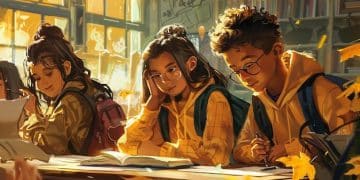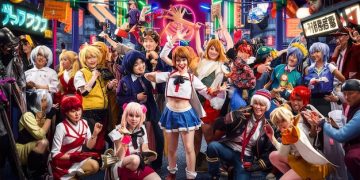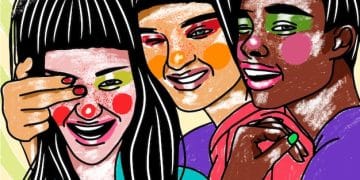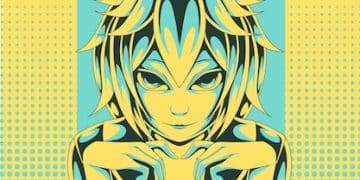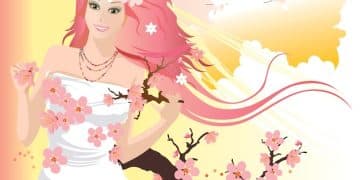The Evolution of Violence in Seinen Manga: 1980s-2025
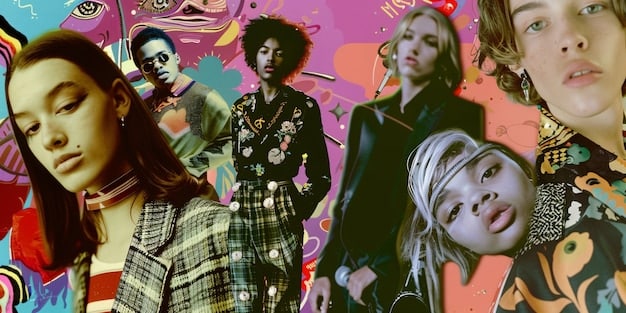
The Evolution of Violence: Tracing the Depiction of Brutality in Seinen Manga from the 1980s to 2025 explores how mature manga has portrayed violence over four decades, reflecting changing social attitudes and pushing artistic boundaries.
The depiction of violence in media has always been a contentious topic, and **the evolution of violence: tracing the depiction of brutality in seinen manga from the 1980s to 2025** offers a unique lens through which to view this phenomenon. Seinen manga, targeted at a mature male audience, often delves into darker and more complex themes than its shonen counterpart, and the portrayal of violence is frequently a key element.
The Rise of Seinen Manga in the 1980s
The 1980s marked a turning point for manga, with the emergence of seinen as a distinct genre. This era saw creators pushing boundaries and exploring more mature themes, including violence, in ways that were previously unseen.
Seinen manga distinguished itself by targeting an older demographic, allowing for greater narrative complexity and thematic depth. Unlike shonen manga, which often focuses on adventure and friendship, seinen frequently delves into darker, more realistic topics.
Key Titles and Their Impact
Several titles from the 1980s played a significant role in shaping the seinen genre. These manga challenged conventions and broadened the scope of what manga could achieve.
- Akira (1982-1990): Katsuhiro Otomo’s cyberpunk masterpiece, Akira, is renowned for its stunning visuals and graphic depiction of violence in a dystopian Neo-Tokyo.
- Angel Heart (1985-1988): While not as overtly violent as some other seinen titles, Angel Heart explored themes of guilt, redemption, and the psychological impact of violence on both perpetrators and victims.
- Violence Jack (1973-1990): Go Nagai’s post-apocalyptic manga, Violence Jack, pushed the boundaries of graphic violence and sexual content, establishing a precedent for extreme depictions in seinen manga.
The 1980s laid the foundation for the seinen genre, showcasing a willingness to tackle complex themes and push the boundaries of what manga could achieve. This era saw the rise of influential titles that continue to resonate with readers today.
Increased Realism and Graphic Depictions in the 1990s
Building on the foundations laid in the 1980s, the 1990s witnessed an intensification of violence in seinen manga. Creators began to embrace greater realism and graphic depictions, often exploring the psychological consequences of violence on characters.
The desire for authenticity led many artists to create darker, more visceral representations of violence. This era saw the rise of manga that unflinchingly depicted the brutality of war, the horrors of crime, and the fragility of human existence.
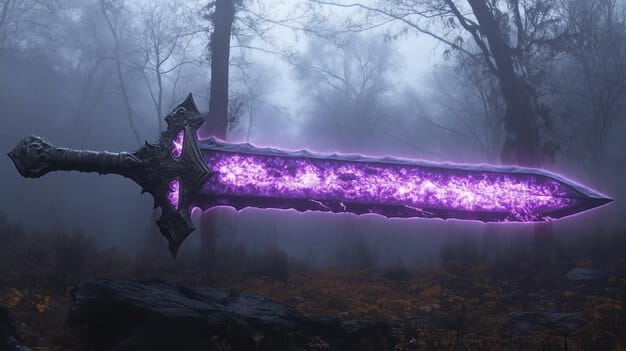
Examples of Intense Violence in 1990s Seinen
The 1990s featured several manga series known for their unapologetic portrayal of violence. These titles remain some of the most influential in the seinen genre.
- Berserk (1989-Present): Kentaro Miura’s Berserk is notorious for its unrelenting violence, dark fantasy setting, and complex characters grappling with trauma and survival.
- Blade of the Immortal (1993-2012): Hiroaki Samura’s Blade of the Immortal features intense sword fights and graphic bloodshed. The manga explores themes of revenge, morality, and the consequences of immortality.
- GTO: Great Teacher Onizuka (1997-2002): While primarily a comedy, GTO occasionally delves into serious issues such as bullying, abuse, and societal pressures. Violence is sometimes used as a catalyst for change.
The more realistic and graphic depictions of violence in 1990s seinen manga reflected a broader cultural shift towards grittier and more unflinching storytelling. These manga challenged readers to confront uncomfortable truths about human nature and the world around them.
The Late 1990s and Early 2000s: Psychological Impact and Social Commentary
As the seinen genre matured, creators began to explore not only physical violence but also its psychological impact on characters and society. This era saw the emergence of manga that used violence as a means of social commentary.
Many artists used violence to explore themes of trauma, PTSD, and the long-lasting effects of conflict on individuals and communities. By focusing on the psychological toll of violence, these manga offered a deeper and more nuanced understanding of its consequences.
Social Issues Explored Through Violence
Violence became a tool for examining broader social and political issues. These manga often depicted corrupt institutions, societal inequalities, and the human cost of war.
Manga like *Gantz* and *Battle Royale* used extreme violence to critique societal values and explore the darker aspects of human nature. These series often presented scenarios where characters were forced to make difficult choices in the face of overwhelming odds, highlighting the ethical dilemmas inherent in violent situations.
- Gantz (2000-2013): Hiroya Oku’s Gantz combined science fiction elements with graphic violence, exploring themes of morality, survival, and the value of human life.
- Battle Royale (2000-2006): Koushun Takami’s Battle Royale depicted a dystopian society where schoolchildren are forced to fight to the death, offering a stark critique of government control and societal conformity.
The late 1990s and early 2000s marked a period of greater introspection and social awareness in seinen manga. By exploring the psychological impact of violence and using it as a means of social commentary, these manga offered readers a more complex and thought-provoking experience.
Modern Seinen: Nuance and Deconstruction (2010s-2025)
In recent years, modern seinen manga has taken a more nuanced and deconstructive approach to violence. Creators are increasingly interested in examining the roots of violence, its cultural context, and its representation in media.
Violence is often used as a tool to challenge traditional narratives and explore alternative perspectives. This era has seen the rise of manga that question the glorification of violence in popular culture and offer more complex and critical portrayals.
Deconstructing Violent Tropes
Many modern seinen manga actively deconstruct traditional violent tropes, questioning the motivations of characters, the consequences of their actions, and the impact of violence on society.
Manga such as *Vinland Saga* challenge the romanticized notion of Vikings and explore the futility of revenge. By presenting a more realistic and human portrayal of Vikings, these series invite readers to reconsider their understanding of violence and its historical context.
- Vinland Saga (2005-Present): Makoto Yukimura’s Vinland Saga, though starting earlier, gained prominence in the 2010s and continues to explore themes of pacifism, revenge, and the search for meaning in a violent world.
- Ajin: Demi-Human (2012-2021): Gamon Sakurai’s Ajin: Demi-Human explores themes of prejudice, fear, and the ethical implications of scientific research. The series uses violence to highlight the dehumanization of marginalized groups.
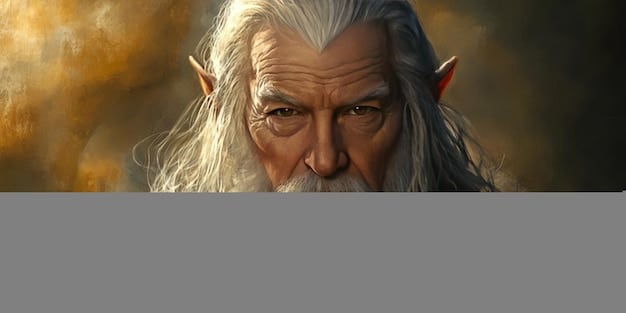
Modern seinen manga is characterized by its willingness to challenge conventions and offer more critical and nuanced portrayals of violence. By deconstructing violent tropes and examining the social and cultural context of violence, these manga invite readers to engage in deeper and more meaningful discussions.
Artistic Styles and Visual Representation of Violence
The artistic styles employed in seinen manga have played a crucial role in shaping the visual representation of violence. From the highly detailed and realistic depictions of the 1990s to the more stylized and symbolic representations of recent years, artists have used a variety of techniques to convey the impact of violence.
Detailed linework, dynamic panel layouts, and innovative use of perspective have all contributed to the immersive and visceral experience of violence in seinen manga. Artists often employ heavy shading and dramatic lighting to create a sense of tension and unease, drawing readers into the dark and violent worlds they depict.
Evolution of Artistic Techniques
Over the decades, artistic techniques in seinen manga have evolved to reflect changing attitudes towards violence. Early seinen manga often relied on shock value and graphic imagery to convey the brutality of violence.
More recently, artists have begun to experiment with more subtle and symbolic representations of violence, focusing on the psychological impact on characters and the broader social context. This shift towards greater nuance and sophistication has allowed artists to convey the complexities of violence in more meaningful ways.
- Detailed Realism: Series like *Berserk* and *Blade of the Immortal* are known for their highly detailed and realistic depictions of violence, often featuring intricate sword fights and graphic bloodshed.
- Stylized Symbolism: Series like *Vinland Saga* and *Ajin: Demi-Human* employ more stylized and symbolic representations of violence, focusing on the psychological impact on characters and the broader social context.
The evolution of artistic styles and visual techniques in seinen manga has been instrumental in shaping the portrayal of violence. By experimenting with different approaches and pushing the boundaries of visual storytelling, artists have continued to challenge readers and deepen their understanding of violence.
Future Trends: The Evolving Landscape of Violence in Seinen Manga (2025)
Looking ahead to 2025 and beyond, the landscape of violence in seinen manga is likely to continue evolving. As societal attitudes change and new artistic techniques emerge, creators will continue to find innovative ways to explore the complexities of violence.
Emerging trends suggest a greater emphasis on nuanced storytelling, psychological realism, and social commentary. Future seinen manga may delve even deeper into the roots of violence, exploring its cultural context and its impact on individuals and communities.
Anticipated Developments
Several potential developments could shape the future of violence in seinen manga. These include:
- Increased Diversity of Perspectives: Future seinen manga may feature a wider range of perspectives on violence, including those of women, people of color, and other marginalized groups.
- Greater Focus on Mental Health: As awareness of mental health issues continues to grow, future seinen manga may devote more attention to the psychological impact of violence on characters.
- Experimentation with New Technologies: Emerging technologies, such as virtual reality and augmented reality, could offer new ways to experience and engage with violence in manga.
The future of violence in seinen manga is uncertain, but it is clear that creators will continue to explore this complex and challenging topic in innovative and thought-provoking ways. As societal attitudes change and new artistic techniques emerge, the representation of violence in seinen manga is likely to evolve in unpredictable and exciting ways.
| Key Point | Brief Description |
|---|---|
| 💥 Early Seinen | Established mature themes and narrative complexity. |
| 🔪 1990s Violence | Increased realism and graphic depictions. |
| 🧠 Psychological Impact | Explored trauma and societal issues through violence. |
| 🎨 Modern Nuance | Deconstruction and nuanced storytelling in current manga. |
FAQ
▼
Seinen manga targets older male audiences, typically 18+, allowing more mature themes and complex narratives compared to shonen manga aimed at younger teens. It often explores nuanced social commentary and darker topics.
▼
Early Seinen used shock value, while later series focused more on the psychological effects and social implications. Modern manga often deconstructs violence tropes, offering a realistic view exploring cultural contexts.
▼
Notable titles include “Akira,” “Berserk,” and “Vinland Saga.” Each represents different eras and approaches to depicting violence, from dystopian settings to dark fantasy and historical contexts.
▼
Art styles vary from detailed realism in series like “Berserk” to stylized symbolism in “Vinland Saga”. These styles enhance the visceral impact or psychological implications of violence, influencing reader perception.
▼
Anticipated trends include diverse perspectives, a greater focus on mental health, and using technology to enhance storytelling. Future manga could push boundaries even further, providing more personalized storytelling.
Conclusion
The exploration of violence in seinen manga has evolved significantly from the 1980s to 2025, reflecting changing societal views and artistic expression. As the genre continues to mature, it promises to offer deeper, more nuanced portrayals of brutality, challenging readers to confront complex themes and consider the human condition.
